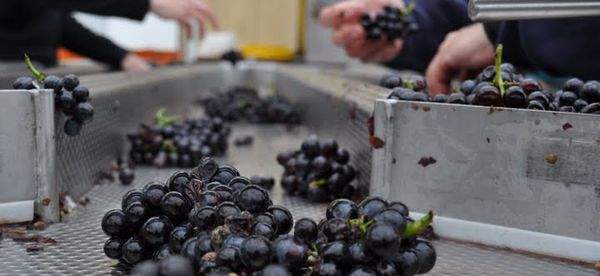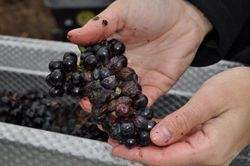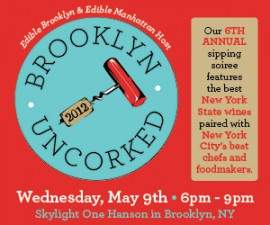Out of Sorts… Comes a Wine More Special
Photos courtesy of Heart & Hands Wine Company
By Evan Dawson, Finger Lakes Editor
This whole hand sorting business seemed like a good idea — until I nearly threw up on the sorting table. And it wasn't the fact that this was a vibrating table that turned my stomach.
Let me back up. Most wine producers in the Finger Lakes do not hand sort the fruit after it's picked. They rely on vineyard crews to make careful passes when the fruit is still hanging, cutting off the rotting, green or — worse — sour fruit. Once the fruit is picked, it is crushed and often de-stemmed. The sorting has already been done in the vineyard.
The challenge is to identify all or most of the problem clusters and berries before they're picked. And it's not as simple as cutting off whole clusters; sometimes a cluster of grapes will be largely clean with the exception of a few problem berries. But those berries are big problems.
Last weekend I joined the sorting crew at Heart & Hands Wine Company on Cayuga Lake as they sorted one of the first waves of pinot noir for still wine. The fruit had come from Sawmill Creek Vineyard on Seneca Lake, and our task was simple: Check each cluster for "green" fruit (under-ripe berries), botrytis (raisined or rotting berries), and sour rot (more on that in a moment). Most clusters were beautiful, and we simply passed them straight to center sorting lane, where they were transferred to the bin. But some entire clusters were affected, and in other clusters we found ourselves picking out the ripe berries and tossing the rest.
This is time-consuming work. Bigger operations that make thousands upon thousands of cases of wine each year might not be able to afford a sorting crew for every batch of grapes. Smaller artisan producers, like Heart & Hands, tend to invite friends and frequent customers to volunteer.
It was the sour rot berries that stunned me. As in, stunned me like smelling salts would stun me.
Take a look at the photograph — you can see the cluster, largely healthy on the edges but affected by sour rot in the middle. The grapes, which are like vinegar, are an aromatic nightmare, something that Tim Burton might create if he were directing a movie called War of the Noses. At a distance of two feet the sour rot grapes smell like a sock freshly peeled from a long-distance runner's foot.
You might imagine my horror when three of these berries entered my mouth.
See, we taste a lot of the berries during sorting to make sure the clusters are ripe. I was tossing things into my mouth haphazardly when it happened, and I ejected the sour grapes from my mouth which such violence that I nearly pulled my neck as I instinctively spat away from the sorting table.
Tom and Susan Higgins nearly pulled their ribcages laughing at me.
"I guess you have to taste the bad grapes to understand just how bad they are," Higgins says. "Well, most people just smell it and know."
Consider that after six tons of pinot noir grapes had been sorted, crews had removed more than 700 pounds. That's a full 6% of grapes removed for a variety of problems, and there's no doubt the finished wine would have been affected by that 6%.
"The sour berries elevate volatile acidity," Higgins explains. "A very small number can have a very serious impact."
And now look at the difference: That batch of grapes arrived showing between 23 and 24 brix (essentially a measurement of sugar). After sorting, the pinot showed 25.4 brix. It's the highest reading Higgins has seen for pinot noir in the Finger Lakes. "We're sorting all of the junk," he says. "It's a huge investment in time and energy, but it's worth it."
Over at Hermann J. Wiemer on Seneca Lake, owner and winemaker Fred Merwarth feels the same way. "I can't imagine doing it differently," Merwarth says. "It makes for some extremely long nights. We were sorting until midnight recently, but when you commit to sorting, you find a way to do it."
Higgins can relate. "The first day Susan and I ever sorted, we were delirious at three o'clock in the morning still sorting away."
I have seen hand sorting at Anthony Road and at Ravines Wine Cellars, but I'm not aware of it happening elsewhere. I'd love to hear from other producers about whether they sort and why they do or do not. It's not the only way to make wine, and certainly the best vineyard managers are making sure the fruit is coming in extremely clean. But my mind returns to those sour rot berries.
I hope there is no lasting effect on my body. I fear there would have been a lasting effect on the wine.



















I’m curious about the brix readings: assuming the use of a refractometer or other reliable method, how does removing only 6% of the bulk of the grapes swing an entire averge up as many as 2 brix, especially when many of the grapes removed were botrycized (sp?)? Was there an abundance of green grapes in the original sample?
25 brix is quite a high number for a cooler year in the Finger Lakes for any varietal. I’m interested how this all sorts out for such a result!
Jason -
Thanks for your questions. I invite you to come out when we are sorting to help out with this unique opportunity.
In 2006, we had the chance to do a side-by-side comparison with a wine made from field-sorted, hand picked grapes and then ours (which we hand sorted at the crush pad). We were ~ 1 brix higher and 1g/L of TA lower than the first batch. We were sold on this method ever since.
We are removing some of the botrytis fruit, but there is a fair bit of sour rot (leading to VA) and unripe clusters that make there way into the bin. These unripe clusters lead to higher acids and lower brix. I’m not separating the crap fruit to break out the percentages of sour rot/botrytis/green clusters but, to date, we’ve hauled out a little more 1000lbs of grapes we can’t use.
We were also shocked seeing the brix level this high. We actually had to do a re-sample on these two bins to clarify that it wasn’t just a sweet pocket. We look forward to tasting the finished results too!
Cheers,
Tom Higgins
Heart & Hands Wine Company
Thank you for the kind invitation-I would greatly enjoy helping with a future sorting!
While many Finger Lakes wineries are not as meticulous with hand sorting as your operation, there are a few that are and I’ve never been led to believe that the practice has such a dramatic effect on brix (slightly better brix, of course, clean fruit with good flavor, definitely!). What other variables are at play here with your fruit to get such results? Is there something unique about your production methods, sourcing, etc.?
Jason makes a very good point. Sorting out botrytis affected ( noble or not) grapes does not increase the sugar level. In fact, it will decrease the sugar level as winemakers working with Riesling understand. Sorting will only increase sugar level, if you eliminate red or green berries, but then we are not talking about 24-25 brix grapes.
I recently harvested beautiful Pinot Noir grapes, fully ripe but with no rot or shrivelling at a little over 22 Brix. These grapes were grown at about 1.9 T/acre on a lyre trellis system. The lyre trellis system captures probably 50 % more sun light than traditional VSP trellis systems.
Jason -
I think it would be too simple to point to one or two elements in the process which help the process of ripening - however, Mother Nature might be the leading variable.
Also, I try not to use brix as the only component of determining whether fruit is is ripe.
Cheers,
Tom Higgins
Heart & Hands Wine Company
Yes, ripeness is an interesting concept not measured in sugar levels alone.
I’m glad to hear that Mother Nature was kind to you this year (I don’t imagine that’s true for everyone!) and I’d be interested to hear more about your growing sites at some point.
I think that 25+ brix will give you a lot to work with for some amazing pinot potential…cannot wait for the 2009 release!